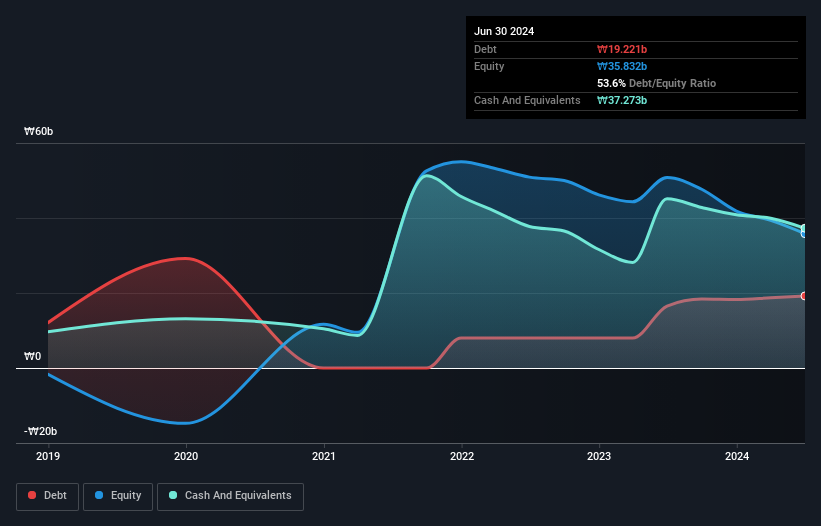
Some say volatility, rather than debt, is the best way to think about risk as an investor, but Warren Buffett famously said that 'Volatility is far from synonymous with risk.' So it seems the smart money knows that debt - which is usually involved in bankruptcies - is a very important factor, when you assess how risky a company is. As with many other companies curacle co.,ltd. (KOSDAQ:365270) makes use of debt. But should shareholders be worried about its use of debt?
Why Does Debt Bring Risk?
Debt assists a business until the business has trouble paying it off, either with new capital or with free cash flow. Part and parcel of capitalism is the process of 'creative destruction' where failed businesses are mercilessly liquidated by their bankers. However, a more common (but still painful) scenario is that it has to raise new equity capital at a low price, thus permanently diluting shareholders. Of course, debt can be an important tool in businesses, particularly capital heavy businesses. The first thing to do when considering how much debt a business uses is to look at its cash and debt together.
View our latest analysis for curacleltd
How Much Debt Does curacleltd Carry?
The image below, which you can click on for greater detail, shows that at June 2024 curacleltd had debt of ₩19.2b, up from ₩16.5b in one year. But on the other hand it also has ₩37.3b in cash, leading to a ₩18.1b net cash position.

A Look At curacleltd's Liabilities
According to the last reported balance sheet, curacleltd had liabilities of ₩27.4b due within 12 months, and liabilities of ₩107.3m due beyond 12 months. On the other hand, it had cash of ₩37.3b and ₩448.4m worth of receivables due within a year. So it can boast ₩10.2b more liquid assets than total liabilities.
This surplus suggests that curacleltd has a conservative balance sheet, and could probably eliminate its debt without much difficulty. Simply put, the fact that curacleltd has more cash than debt is arguably a good indication that it can manage its debt safely. When analysing debt levels, the balance sheet is the obvious place to start. But you can't view debt in total isolation; since curacleltd will need earnings to service that debt. So when considering debt, it's definitely worth looking at the earnings trend. Click here for an interactive snapshot.
Over 12 months, curacleltd made a loss at the EBIT level, and saw its revenue drop to ₩4.0b, which is a fall of 53%. To be frank that doesn't bode well.
So How Risky Is curacleltd?
By their very nature companies that are losing money are more risky than those with a long history of profitability. And the fact is that over the last twelve months curacleltd lost money at the earnings before interest and tax (EBIT) line. And over the same period it saw negative free cash outflow of ₩7.0b and booked a ₩16b accounting loss. But the saving grace is the ₩18.1b on the balance sheet. That kitty means the company can keep spending for growth for at least two years, at current rates. Overall, its balance sheet doesn't seem overly risky, at the moment, but we're always cautious until we see the positive free cash flow. The balance sheet is clearly the area to focus on when you are analysing debt. However, not all investment risk resides within the balance sheet - far from it. Be aware that curacleltd is showing 2 warning signs in our investment analysis , you should know about...
At the end of the day, it's often better to focus on companies that are free from net debt. You can access our special list of such companies (all with a track record of profit growth). It's free.
Valuation is complex, but we're here to simplify it.
Discover if curacleltd might be undervalued or overvalued with our detailed analysis, featuring fair value estimates, potential risks, dividends, insider trades, and its financial condition.
Access Free AnalysisHave feedback on this article? Concerned about the content? Get in touch with us directly. Alternatively, email editorial-team (at) simplywallst.com.
This article by Simply Wall St is general in nature. We provide commentary based on historical data and analyst forecasts only using an unbiased methodology and our articles are not intended to be financial advice. It does not constitute a recommendation to buy or sell any stock, and does not take account of your objectives, or your financial situation. We aim to bring you long-term focused analysis driven by fundamental data. Note that our analysis may not factor in the latest price-sensitive company announcements or qualitative material. Simply Wall St has no position in any stocks mentioned.
About KOSDAQ:A365270
curacleltd
Curacle Co., Ltd., a bio-venture business, engages in the research and development of drugs for diseases caused by aging process and damage to blood vessels.
Flawless balance sheet very low.
Market Insights
Community Narratives


